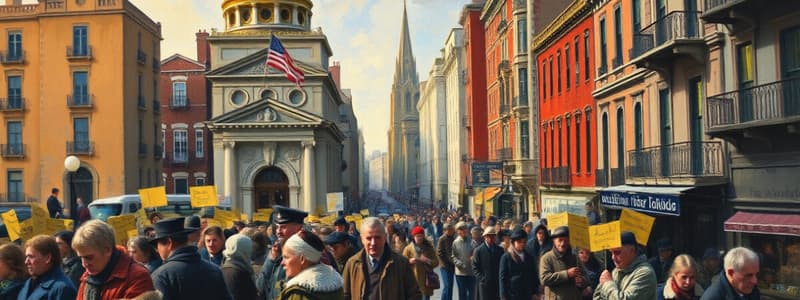Podcast
Questions and Answers
What was the purpose of the Columbian Exposition held in 1893?
What was the purpose of the Columbian Exposition held in 1893?
- To display the progress of American civilization (correct)
- To celebrate the end of the Civil War
- To promote agricultural advancements
- To showcase military technology
Who were considered 'old' immigrants?
Who were considered 'old' immigrants?
The majority arrived before 1880 from Western Europe and the British Isles.
What characterizes 'new' immigrants?
What characterizes 'new' immigrants?
They arrived after 1890 from southern and eastern Europe, often poor and illiterate.
When was the Statue of Liberty opened?
When was the Statue of Liberty opened?
What did the Chinese Exclusion Act of 1882 entail?
What did the Chinese Exclusion Act of 1882 entail?
What was Ellis Island?
What was Ellis Island?
What was the purpose of the contract labor law created in 1885?
What was the purpose of the contract labor law created in 1885?
What organization supported immigration restrictions and was prejudiced against Roman Catholics?
What organization supported immigration restrictions and was prejudiced against Roman Catholics?
What is urbanization?
What is urbanization?
What are streetcar cities?
What are streetcar cities?
What does mass transportation encompass?
What does mass transportation encompass?
What were tenements?
What were tenements?
Who designed the Hull House in 1889?
Who designed the Hull House in 1889?
What was the focus of the Social Gospel movement?
What was the focus of the Social Gospel movement?
Who founded the Salvation Army in the United States?
Who founded the Salvation Army in the United States?
What did the National American Woman Suffrage Association aim to achieve?
What did the National American Woman Suffrage Association aim to achieve?
What was the significance of the Armory Show of 1913?
What was the significance of the Armory Show of 1913?
What is cultural diversity?
What is cultural diversity?
What is meant by the term melting pot?
What is meant by the term melting pot?
Flashcards are hidden until you start studying
Study Notes
Columbian Exposition
- Took place in 1893 in Chicago.
- Aimed to showcase American civilization, innovations, and industrial advancements.
Immigration Waves
- "Old" immigrants: Predominantly from Western Europe, arriving before 1880; marked by high literacy and occupational skills.
- "New" immigrants: Emerged post-1890 from Southern and Eastern Europe, often impoverished and unfamiliar with democratic values.
Key Immigration Symbols
- Statue of Liberty: Inaugurated in 1886, designed by Frederic-Auguste Bartholdi, symbolizing freedom and welcoming new arrivals.
- Ellis Island: Opened in 1892 as a primary immigration processing center in New York Harbor.
Immigration Legislation
- Chinese Exclusion Act (1882): First significant immigration restriction aimed at prohibiting new arrivals from China.
- Contract Labor Law (1885): Enacted to safeguard American workers from competition arising from immigrant labor.
Urban Development
- Urbanization: By 1920, the U.S. experienced a population density shift, leading to rapid city growth.
- Streetcar cities: Emerged as urban neighborhoods where public transportation allowed residency far from workplaces.
Transportation and Infrastructure
- Mass transportation systems included electric trolleys, elevated railroads, and subways, creating socioeconomic segregation.
- Skyscrapers: First constructed with steel skeletons and elevators, revolutionizing city landscapes.
Immigrant Living Conditions
- Ethnic neighborhoods: Provided cultural cohesion for immigrants but often characterized by slum conditions.
- Tenements: Overcrowded housing units managed by landlords to maximize profits.
Suburbanization
- Suburbs emerged as affluent residents relocated from cities, characterized by cleaner environments.
- Frederic Law Olmsted: Renowned landscape architect who designed ideal suburban communities.
Political Landscape
- Political machines: Organized groups dominating urban political structures.
- Party bosses: Led political machines, wielding considerable influence over city governance.
Social Movements
- Henry George: Author of "Progress and Poverty," criticizing wealth disparity in laissez-faire capitalism.
- Settlement houses: Established by middle-class reformers to address the needs of immigrant families, exemplified by Hull House created by Jane Adams.
Religious and Social Reform
- Social Gospel movement: Advocated applying Christian ethics to societal issues stemming from industrialization.
- Walter Rauschenbusch: Key figure in the movement, promoting social justice from a religious perspective.
Women’s Suffrage and Temperance
- National American Woman Suffrage Association: Founded by Elizabeth Cady Stanton and Susan B. Anthony to advocate for women's voting rights.
- Women's Christian Temperance Union: Founded in 1874, calling for alcohol abstinence and led by Frances E. Willard.
Anti-Vice Movements
- Anthony Comstock: Formed the Society for the Suppression of Vice; advocated against pornography and vice.
Educational Advancements
- Johns Hopkins University: Established in 1876, recognized for its focus on graduate studies and research.
- Charles W. Eliot: Harvard president who promoted a flexible curriculum with more elective courses.
Sociology and Law
- Oliver Wendell Holmes, Jr.: Advocated for a dynamic interpretation of law adapting to social changes.
- W.E.B. Du Bois: Prominent African American intellectual, advocating for civil rights and higher education for blacks.
Literature and the Arts
- Significant authors included Mark Twain, Stephen Crane, and Jack London, known for realistic portrayals of American life.
- The Ashcan School: A group of artists focused on depicting urban realities and social issues.
Music and Entertainment
- Jazz: A musical genre blending African rhythms with Western styles, characterized by improvisation.
- Scott Joplin: Notable for ragtime music, with "Maple Leaf Rag" being a major hit.
Journalism Evolution
- Joseph Pulitzer and William Randolph Hearst: Newspaper moguls who transformed journalism through sensationalism and large-scale circulation.
Sports and Public Shows
- Spectator sports grew in popularity among both the working and middle classes, along with amateur sports programs.
- P.T. Barnum and Buffalo Bill popularized large-scale entertainment spectacles, captivating American audiences.
Cultural Dynamics
- Melting pot concept: Reflects the integration and assimilation of diverse cultures within American society.
- Cultural diversity emphasizes maintaining distinct immigrant traditions amidst the broader American culture.
Studying That Suits You
Use AI to generate personalized quizzes and flashcards to suit your learning preferences.




